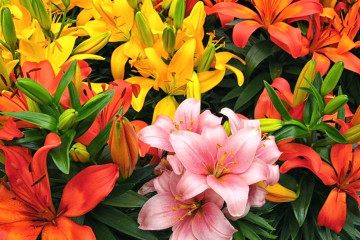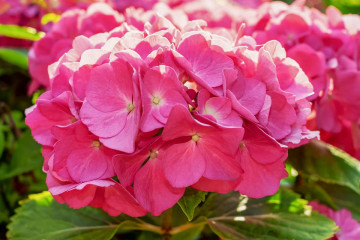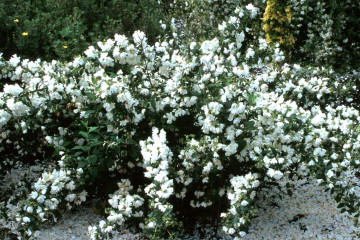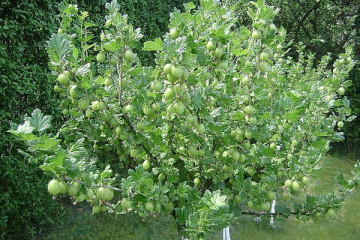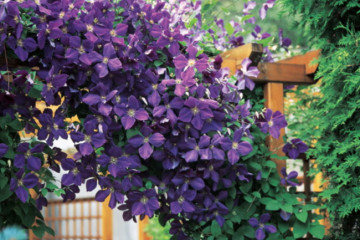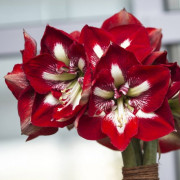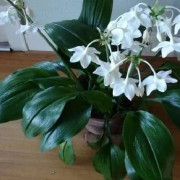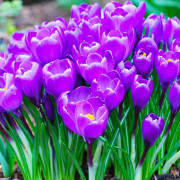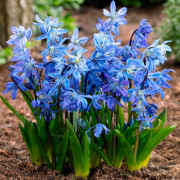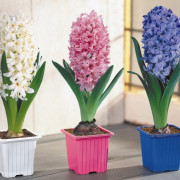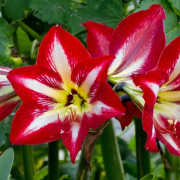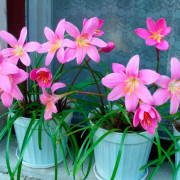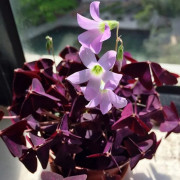How to feed gladioli in spring and summer
Content:
Gladioli are quite demanding species, which are very difficult for a novice gardener to grow. Only following the step-by-step growing rules will allow you to get beautiful blooming gladioli. Poor care can even lead to a complete lack of flowers. It is not enough just to plant a plant, you need to familiarize yourself with the rules of caring for it in advance. Timely watering and feeding will allow not only to get a gorgeous "harvest", but also to collect a large number of children.
Gladioli - how they look and bloom

Flowers in landscape design
The plant belongs to the Iris family. A perennial plant is endowed with long, sharp green leaves. The length of each can be up to 1 meter. The stem is straight, at least 1.5 meters. The inflorescence is lush, about 20 pieces on one branch. The size of the flowers can be different - from 5 to 15 cm.
The color variety is very rich. From classic whites to "newfangled" greens or even blacks. Breeders have also bred two- and three-color gladioli.

Plant appearance
Correct planting is the key to lush flowering
Cultivation of gladioli is recommended to be carried out in a previously prepared area.
In the fall, the selected area in the garden is dug up and fertilizer is applied in the form of any organic matter (rotted manure has proven itself well). In the same period, preparations containing phosphorus and potassium are introduced into the ground. The recommended rate is 2 tablespoons per 1 sq. meter.
In the spring, 20-25 days before planting, urea is added to the prepared wells, no more than 1 tablespoon per 1 * 1 meter area.
Excellent protection for future planting is the well-known Fitosporin. This preparation spills the area where gladioli will grow.
It is important to understand that the appearance and health of the plant directly depends on the quality of the soil. Rapid growth and lush bloom are only possible on “good” soil.
Essential Nutrients Included with Top dressing
How to feed gladioli so that they not only bloom magnificently, but also give children in the future. In the special literature, the following nutrients are highlighted that are necessary for gladiolus at different stages of development:
- Nitrogen.
- Phosphorus.
- Potassium.
- Magnesium.
- Calcium.
- Molybdenum.
- Bor.
- Zinc.
- Copper.
- Manganese.
The above drugs are allowed to be applied individually, or in combination.
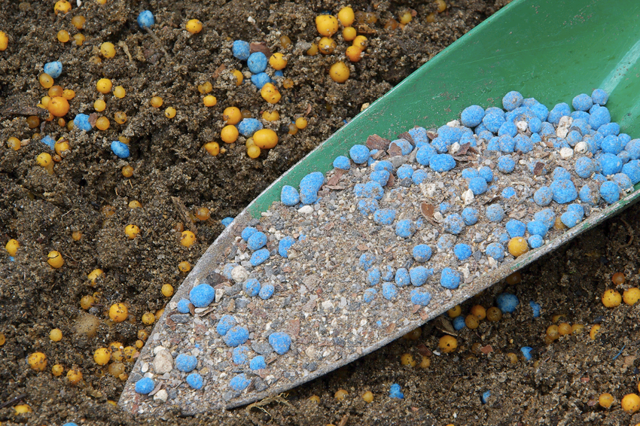
Essential ingredients for gladiolus
Top dressing tips
Feeding gladioli is carried out three times per season. The first time - before disembarkation, the second - immediately at the time of landing, the third - immediately after.
In order for the plant not to “fatten”, it must be properly looked after.Fertilizing the plant can be foliar or watering the flower at the root.
What types of fertilizers are needed for gladioli
Feeding gladioli in the open field at each stage of development requires different preparations. At the initial stage, immediately after planting in the ground, it is nitrogen. It is not difficult to determine its lack - the leaves turn pale, the excess is manifested in the darkening of the green mass.
If you feed the flowers with phosphorus preparations, then the ripening process will occur much faster. It is necessary to fertilize gladiolus already at the stage of the 5th true leaf.
How to fertilize gladioli so that they not only bloom beautifully, but also acquire immunity to diseases? Experts advise using potassium preparations for these purposes.

Fertilizer group
The frequency of feeding
The frequency of watering plants with fertilizers is once a week. This time period is suitable for liquid feeding. In this case, the rate of application of drugs to the soil is divided in half.
The main stages of feeding
How to feed gladioli for abundant flowering? Preparation should be done from the beginning.
- When 2 true leaves appear, the first one is performed - nitrogen. The most suitable drugs are saltpeter, urea, ammonium.
- The second feeding is carried out after 14 days. At this stage, you can use complex fertilizers. The composition should contain nitrogen, phosphorus, potassium.
- The appearance of peduncles is a signal for the third feeding. The easiest way is to scatter superphosphate granules on the ground. For the reaction, it is necessary to immediately moisten with dilute urea.
The duration of flowering depends on the presence of potassium in the soil, it is he who is responsible for high-quality inflorescences. Experts advise using superphosphate and potassium at the same time.
How to feed gladiolus bulbs before planting
Before planting in the ground, the bulbs must be disinfected. A weak solution of potassium permanganate is perfect for these purposes. Soaking the planting material for 30 minutes will not only allow disinfection, but also stimulate the growth of the flower.
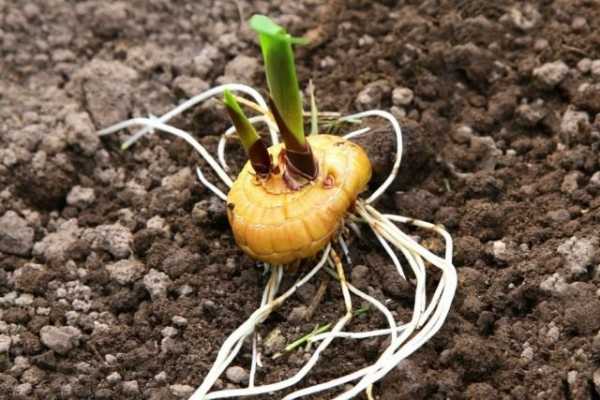
Healthy prepared bulbs
Foliar dressing
Spraying is also recommended for all three flower life cycles. Understanding the question of how to fertilize gladioli before flowering, we must not forget that foliar dressing in June is used to obtain a rich color of inflorescences and increase their number.
Dilute in a bucket of water:
- 15 grams of manganese;
- 15 grams of copper sulfate;
- 10 grams of boric acid;
- 10 grams of magnesium sulfate;
- 1 gram of cobalt;
- 3 grams of zinc.
This solution is universal. It can also be used as the next top dressing. Its purpose is to stimulate the formation of ovaries, that is, children. The optimal time is the month of July.
For the first time, using the foliar method, it is recommended to process the plant at the time of active budding. For these purposes, the following mixture is prepared: potassium permanganate, copper sulfate, boric acid powder. All preparations are mixed in equal proportions of 20 grams and diluted in a bucket of warm water.
When to finish feeding
When the flowering ends, it is necessary to carry out the last dressing. Dissolve 1.5 tablespoons of superphosphate and potassium in a bucket of water.
The final stage is the cultivation of the land with diluted manganese. Just 5 grams is enough for a bucket of warm water.
All feeding should stop in late summer or early autumn, after collecting all the babies.
How to water properly

Proper watering of the plant
Before watering gladioli with fertilizer, the ground should be pre-moistened.
Before each top dressing, the soil must be thoroughly loosened and weeds removed.Watering is carried out not only under the root of the flower, but also the aisles are carefully shed. Evening is considered the most acceptable time.
Fertilizers of gladioli for abundant flowering
Gladiolus is one of those plant species that require different fertilizing for each stage of their life.
Types of organic fertilizers for feeding gladioli
Most often, the following organic substances are used to feed gladioli:
- Compost They represent rotted waste products of a person, vegetation. They are able not only to nourish, but also to enrich the soil.
- Ripe manure. It is recommended to use overripe for several years.
- Chicken droppings. Can only be used diluted.
Before using organic matter, it must be diluted in a 1: 1 ratio and insisted for 14 days. The resulting concentrate is diluted with water 1:20.
Fertilizing with mineral fertilizers
It is recommended to buy fertilizers based on mineral preparations exclusively in specialized stores.
They must contain a nutrient that is essential for the healthy development of the plant. In the case of gladiolus, this can be:
- nitrogen-containing drugs;
- phosphoric agents;
- potash fertilizers.
Fertilizer complexes for additional feeding
Complex fertilizers can consist of two or several components at once. It is recommended to use two-component, consisting of nitrate and potassium magnesia. The use of three-component will allow you to solve several problems at once - to feed the flower and stimulate the immune system.
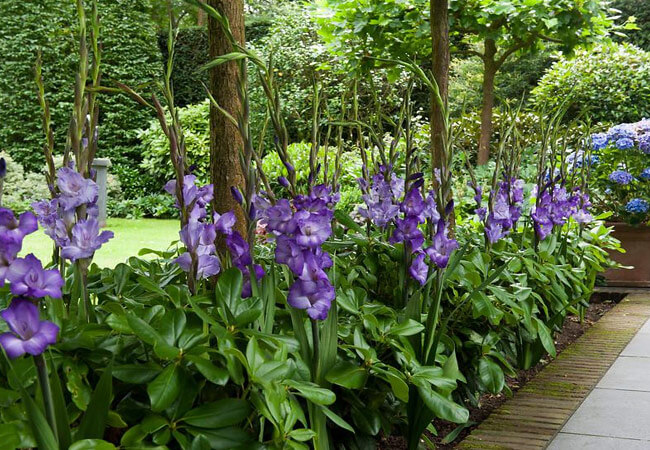
Healthy plant
It is important to understand that you cannot just take and "feed" a flower with this or that drug. Any fertilizers can be applied only if there is a shortage of them.
A prerequisite for a properly conducted agricultural technique is special analyzes. Soil samples are taken to the laboratory and in the conclusion all the components of which it consists will be indicated. This procedure should be carried out at least once every 3 years.
Regardless of what time of year the plant was planted, the preparations for application to the soil are identical. In spring - nitrogen, in summer - potassium and phosphorus.
Folk remedies for feeding
Folk remedies are used in plant growing and floriculture, not only due to the cost reduction, but also due to the lack of chemical components.
Ingredients for such dressings can be picked in the garden or taken at home. Most often these are human waste products or vegetation that surrounds everyone.
The main thing, as with purchased fertilizers, is to observe the dose and follow the instructions for preparation.
How to prepare top dressing with your own hands
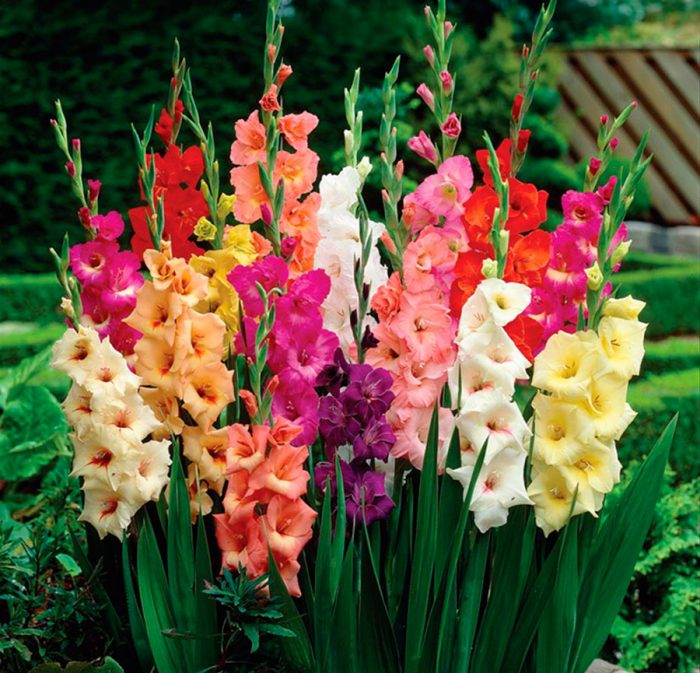
Gladiolus is a real decoration of the site
A proven folk remedy used to feed gladiolus is nettle infusion. This plant contains a lot of useful substances: nitrogen, potassium, a whole group of vitamins, iron.
The recipe is as follows:
- Prepared dishes must be filled 1/3 with chopped nettle.
- The rest of the volume is topped up with water.
- It is necessary to insist the remedy for 5-7 days.
- The concentrate is diluted for introduction into the soil in a ratio of 1:10.
- It is recommended to pour no more than 200 ml of the resulting composition under each bush.
Gladiolus is considered a "complex" flower, which not everyone can take care of. It is important to understand that only after studying all the rules of feeding and observing the elementary requirements for caring for gladiolus, you can get a healthy plant and achieve abundant flowering.Proper care and a responsible attitude to the process will allow you to admire the gladiolus for 5-7 years.
